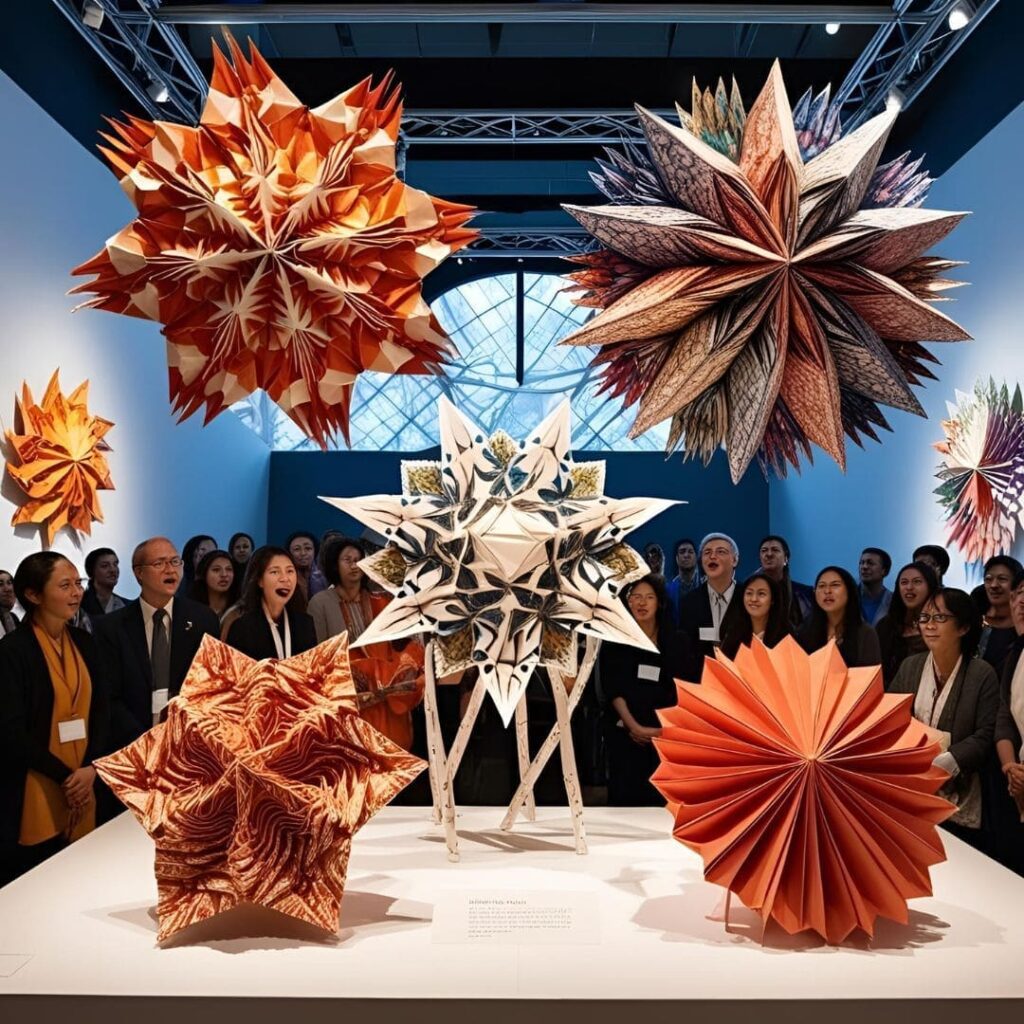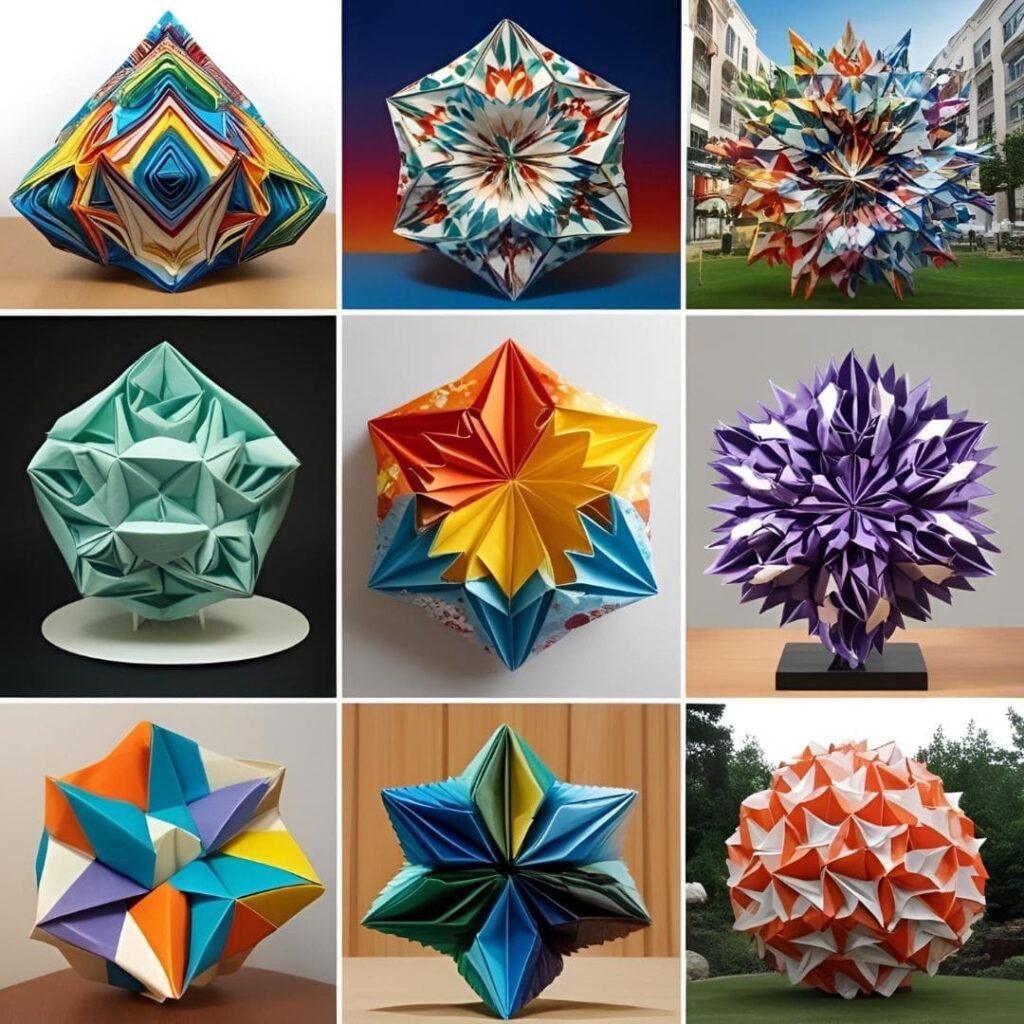Sculptural origami is an art that combines skill, patience, and creativity. For those who have already ventured into the folds of origami, challenges become a great way to grow artistically. If you want to improve and also find inspiration, this post offers three main themes: 30-day origami challenges, how to create your own original model, and the most impressive sculptures in the world created by origami masters.
Get ready to discover new creative horizons and expand your repertoire in the world of sculptural origami!
Great Sculptural Origami Projects to Challenge Yourself: 30-Day Practice List
Challenging yourself is one of the best ways to grow as an artist. In sculptural origami, this means stepping out of your comfort zone and trying new techniques and more complex forms. If you’re looking to improve your skills, here’s a 30-day practice list, with daily challenges to put your technique to the test.
1. Days 1-5: Basic and Simple Folds
Start with the fundamentals. Master modular origami and the reverse fold to build simple pieces, like geometric shapes or basic animal figures.
2. Days 6-10: Traditional Origami with Details
Try folding animals and flowers using fine papers, like washi. Challenge yourself to create a lotus flower or a bird in flight.
3. Days 11-15: Modular Origami Models
Choose a modular model to create more complex shapes, such as polyhedra or 3D geometric sculptures. Learn to combine several units to form a cohesive piece.
4. Days 16-20: Wet Folding Advanced Techniques
Introduce wet folding and learn how to give volume to your pieces. Sculpting a dragon or animal bust could be a good goal.
5. Days 21-25: Tesselations (Geometric Patterns)
Explore the world of tesselations. Challenge yourself to create repeating patterns, like squares or hexagons, that interlock to form more intricate designs.
6. Days 26-30: Free Sculptural Origami
Now, try creating sculptures more freely, based on the techniques you’ve learned. Experiment with double reverse folds and incorporate different shapes and textures to compose a unique model.
Throughout the 30 days, not only will you improve your skills, but you’ll also learn how to tackle bigger challenges. Document your progress in photos and videos to track your growth!


How to Create Your Own Original Sculptural Origami Model (And Diagram It)
Creating your own sculptural origami model is one of the most rewarding experiences for any origami lover. This process involves more than just folding; you need to understand the mechanics of the folds and how they connect to create three-dimensional shapes. Here’s a guide to creating your own model.
1. Choose a Theme or Shape
The first step is deciding what you want to create. It could be an animal, a human figure, or even an abstract sculpture. Choosing a theme will help give direction to your work.
2. Sketch the Folds
Before you start folding the paper, sketch out your model. This will help you visualize the folds and the structure you want to achieve. Draw the fold lines and think about how each section of the paper will interact with the next.
3. Test with Simple Paper
Use plain paper to test your folds and the alignment of the shapes. Try different folding techniques until you find the right form. Remember, origami is a process of trial and error, so don’t be afraid to redo the folds.
4. Create the Diagram
After finalizing your model, start creating the diagram. Clearly mark each step, indicating where the folds should be made and the ideal angle. There are origami diagramming software programs, such as Origami Designer or even Adobe Illustrator, that can make the process easier.
5. Refinement and Adjustments
With the diagram ready, refine the folds and the model. Test various versions, adjusting small details until the final design is perfect. Once you’re happy with it, share it with other origami artists for feedback.
Creating an original sculptural origami model isn’t easy, but the reward of seeing an idea come to life with paper folds is truly unique!
10 Most Impressive Origami Sculptures in the World (And Their Creators)
Now, let’s find some inspiration from the works of origami masters. Here are the 10 most impressive origami sculptures, showcasing the level of skill and creativity that can be achieved.
1. “Great Dragon” by Satoshi Kamiya
This dragon is one of Kamiya’s most famous sculptures. Made from a single square of paper, the piece demonstrates an incredible level of detailing, with each fold creating realistic textures.
2. “Phoenix” by Boris S. A. Ogg
Boris Ogg created an impressive phoenix using wet folding. The sculpture conveys both movement and majesty, being one of the most notable examples of sculptural origami.
3. “Dragon Bust” by Robert J. Lang
Robert Lang is famous for his complex origami sculptures, and this dragon bust is one of his most detailed pieces. Every fold was meticulously planned to capture the essence of the mythical creature.
4. “Dolphin in Motion” by Josef Albers
This dolphin captures the grace and movement of the sea creature. The sculpture is made from a single sheet of paper and uses wet folding to give the piece form and fluidity.
5. “Horse” by Michael LaFosse
Michael LaFosse is known for his animal sculptures, and his horse is a stunning example of his talent. The dynamic posture of the piece conveys energy and grace, showing the mastery needed for sculptural origami.
6. “Bird” by Akira Yoshizawa
Akira Yoshizawa, one of the pioneers of modern origami, created many innovative models, including this bird in flight. His unique technique and fluid style transformed origami into a true art form.
7. “Lotus Flower” by Chizuko Sato
Chizuko Sato’s lotus flower is a beautiful example of how origami can represent the beauty of nature. The piece is meticulously folded to create delicate layers and a sense of lightness.
8. “Lion” by Hideo Komatsu
Komatsu’s lion is an impressive artwork, with intricate details in its shapes and textures. Every fold was made to emphasize the majesty of the animal.
9. “Origami Man” by John Montroll
This origami man is a perfect example of how fold artists can create realistic human figures. John Montroll is known for his lifelike pieces, and this model is one of the most challenging.
10. “Abstract Sculpture” by David Brill
David Brill uses origami to create stunning abstract sculptures. His work explores geometric shapes and modern concepts, taking origami to a new artistic level.
Find Inspiration and Elevate Your Origami
By challenging yourself with new projects, creating your own models, and seeking inspiration from the great masters, sculptural origami can become not just a hobby but a lifestyle. Don’t be afraid to explore your own creations and push your limits!









